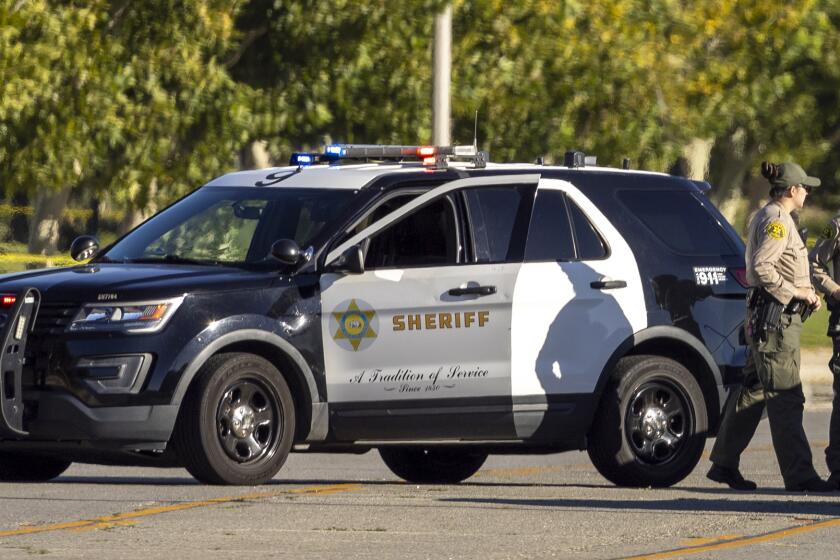Pursuing the Unthinkable in Baby Death
- Share via
Rick King works homicide.
Not too much bothers him, because that would interfere with his work. He’s an Orange County deputy district attorney, married, with two young kids. He has 10 years on the job.
He talks about a recent case:
“That was a very tough one on me. When they opened the casket, he had this little blue paisley sport coat on. It was really tough.”
The child was 2 years old. He lived in Garden Grove. By the time that King saw him, he’d been buried for about a year.
Nobody thought it was murder; not back then, or at least, not out loud. The year was 1987. The live-in housekeeper was the one who had sought help. She’d been alone with the child.
He hit his head on the coffee table, is what she told the police. It was an accident , she said.
Accidents are still the leading cause of unnatural childhood death. Often, there is little proof of anything else.
An autopsy showed a fracture at the temple of the little boy’s skull. There were no witnesses who could offer any other clues. The case, for the time being, was closed.
Some six months later, King took a look. It was just one of those things, when the timing was right.
The county’s Child Death Review Team had just been formed. The group has six members: a police officer, a doctor, a social worker, a pathologist, a coroner and a deputy district attorney. They meet once every two months. They try to make sure that no murderers get away.
Today the group reviews the death of every child who dies in Orange County under the age of 12. In 1989, the most recent year for which precise statistics are available, that meant 334 children.
Most of them died of natural causes, including 53 babies whose deaths were listed as SIDS--sudden infant death syndrome--among the most frightening words that a parent can hear.
Accidents claimed another 67 young lives, and 11 children were murdered by means not too difficult to surmise: They were shot, battered or suffocated. One 3-week-old baby, denied food and water, starved.
Still, the coroner’s office found that it did not have enough evidence to show how another five children died. “Undetermined,” reads their cause of death. They may have been murdered, or perhaps it was SIDS. It is on cases such as these that the review team’s most intense investigations begin.
It is sad, horrifying and, ultimately, satisfying work.
The case of the Garden Grove toddler is an example that King notes. A neuropathologist from the coroner’s office took a closer look at the X-rays of the child’s skull. He thought he saw evidence of yet another skull fracture, this one at the base. This suggested that much more force was used. The coffee table story was raising doubts.
Investigators began following other leads. The toddler’s body was dug up. A family in Los Angeles had fired the same housekeeper after they suspected that she was abusing their child. The woman, who is Mexican, had since left for home. Authorities in Guanajuato, Mexico, have issued a warrant for her arrest. They, and the Americans, believe she murdered the child.
The woman still has not been found.
King says his office has prosecuted about 10 such baby murder cases since the review team was formed. The defendants have been convicted in each one.
Most recently, Nicolas Aranda was found guilty last month of murdering his 10-week-old son. The body of baby Anthony was exhumed after the initial autopsy failed to determine an exact cause of death. More tissue samples showed a newer injury, caused by “blunt-force trauma.” The jury voted to convict in an hour and a half.
“When we used to try baby-killing cases before, we thought, ‘Oh, gosh, well, let’s go,’ ” King says, a grimace spreading across his face.
“You knew they were difficult cases. The evidence was there before, you just didn’t know how to get it. Now we have a lot more on our side. . . .
“I don’t feel any moral crusade. What I do feel is that if a person, with malice, hurts a child, then that person should be punished. That deserves a little extra attention.”
And the job will always be grim.
“You go over to the coroner’s office and you see these bodies. They look like mannequins. They don’t even look real,” King says.
“Except the babies. They look like they’re asleep. They look like they are going to get up and play dolls. They look like they’re going to get up and walk away.”
More to Read
Sign up for Essential California
The most important California stories and recommendations in your inbox every morning.
You may occasionally receive promotional content from the Los Angeles Times.













